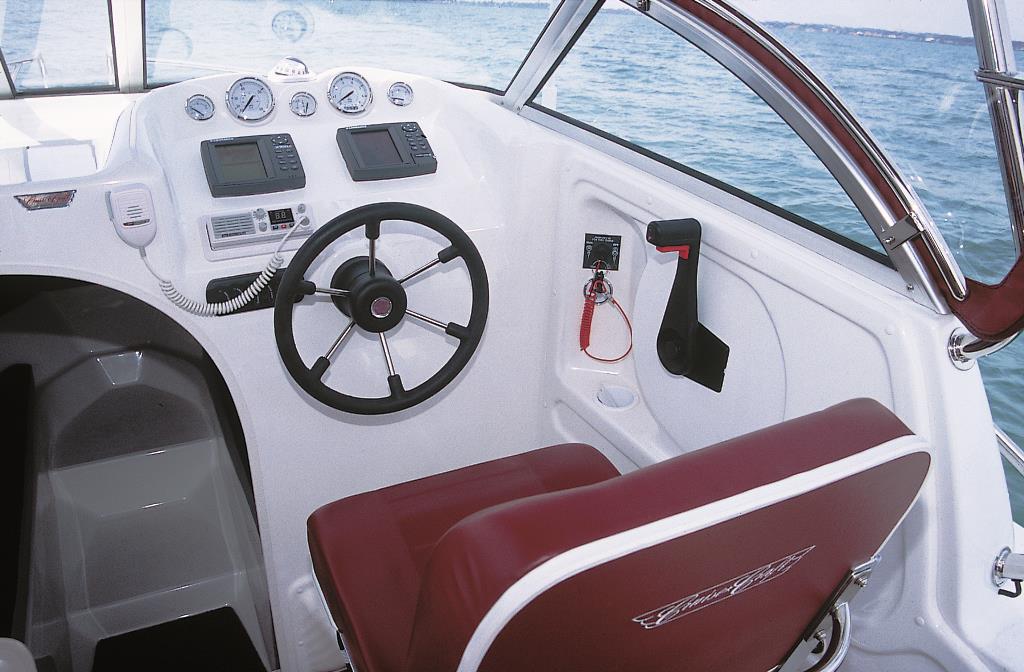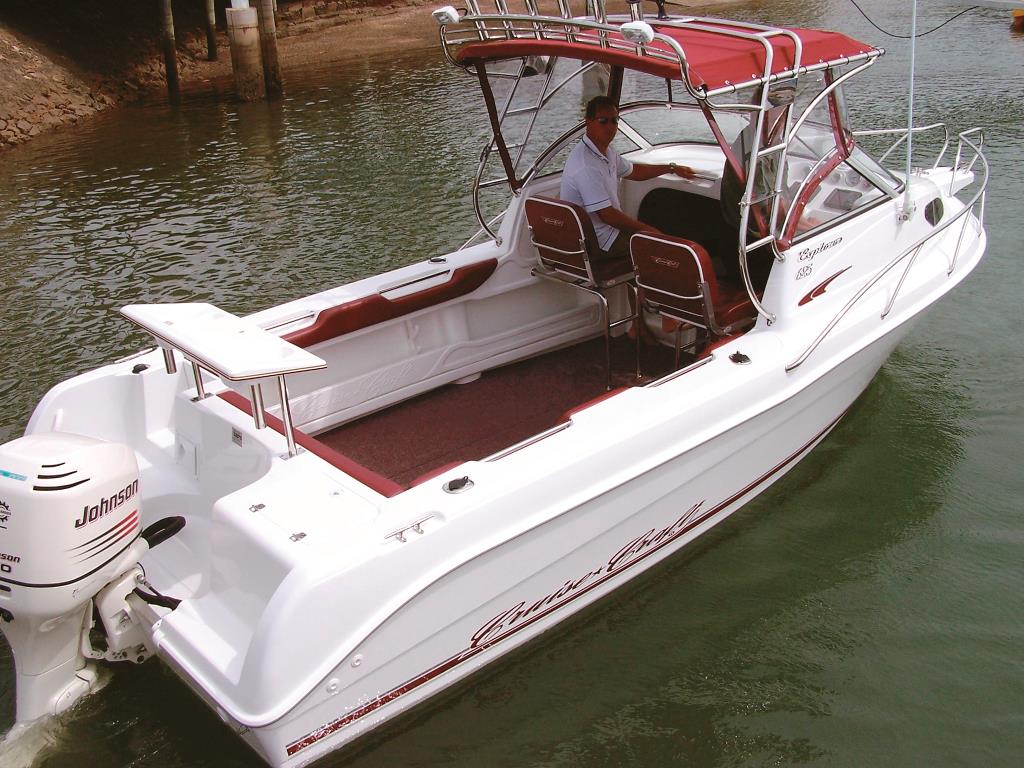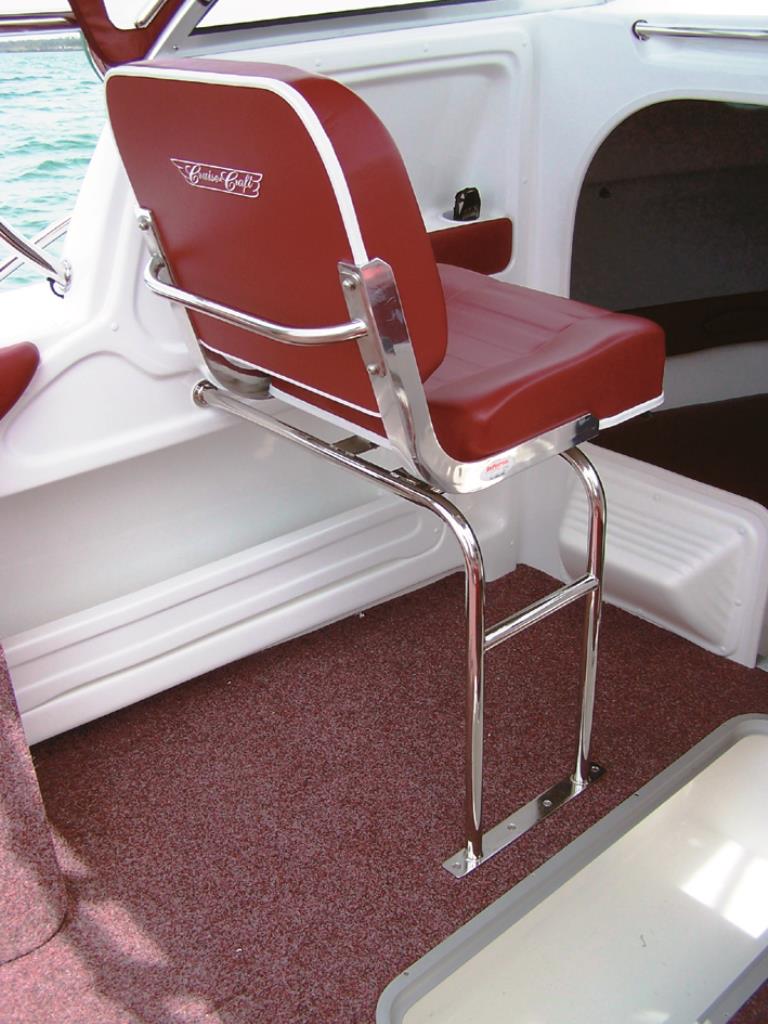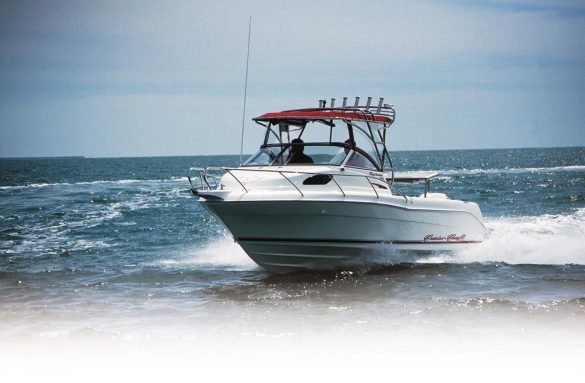Author : Barry Tyler
Going Exploring
Having put to bed the complete re-vamp of their bowrider side of the expansive Cruise Craft range, next in line for Nichols Bros was their cuddy range. Some models are to receive a cosmetic make-over to bring them into line with the very latest market expectations, in instances such as their latest Cruise Craft Explorer 625 however, it was a complete new ‘generation’ upgrade from stem to stern for what would be the largest boat in their Explorer Series.
The second boat in the Cruise Craft range to fully comply with level one of the new buoyancy regulations, this Cruise Craft Explorer 625 model replaces the legendary Explorer 600, arguably one of the most popular Cruise Craft models ever made. Nichols Bros knew what they wanted to do to improve their ‘old’ model, and they figured the only appropriate way to keep the boat still in proportion – was to start with a new model rather than simply lengthening the old 600. Ostensibly the Explorer range is fishing orientated, seriously fishing orientated, so they needed to incorporate even more of the one most important pre-requisite to a fisherman – space. Especially in a boat of this size and stature that fits so conveniently into the ‘bluewater’ category. It is this bluewater aspect in fact that is of paramount importance to the Cruise Craft team, for as CEO Kevin Nichols so rightly points out, “Our boats are perceived as one of the top offshore platforms, and when you fish the outer reefs it is a long way home when the weather changes as it can do, so dramatically and so quickly,” he said. “We owe it to the people who buy our boats, to provide them with the very latest in hull design and thinking, so they can fish these reefs relaxed in the knowledge they are in safe hands when the weather cuts up.”
‘Just a Fishing Boat’ It is in fact what I felt was the ultimate insult to describe this boat as just a ‘fishing boat’, for it was a lot more than that. Yes, it had a large cockpit, courtesy of the extra length Nichols mentioned, plus the helm is further forward in this new model too, further accentuating the size of the ‘self- draining’ cockpit – but there was so much more to this boat that so purposefully leads it into the ‘family’ boat category also. Non-fishing items such as carpet, windscreen grab-rail, stern eyes, step-thru transom upright, transom boarding ladder, deluxe seats, on S/S frames, upholstered storage bins, cabin shelving – all combined well with optional extras such as folding rear lounge, cabin lining, and the rocket launcher Targa arch and bimini. While these were nice features for fishermen they are not necessarily mandatory. But in a ‘family’ situation they may be just the items to ‘tip the scales’ and get the family interested in boating and fishing also. From the moment you stepped aboard you were left in no doubt this was still a fairly serious fishing boat, despite their slight attempt to disguise the fact. No duck-boards, a boarding ladder that folded up right out of the way, an uncluttered portofino platform if you did need to get right to the stern to retrieve your fish, a remote deck-wash hose, transom live-well, padded coaming faces, cockpit lighting, recessed grab rails above these, good wide coaming tops that were comfortable and wide enough to sit on, recesses for fire extinguisher and EPIRB, full-length cockpit side pockets for storage of rods (in special racks) and incidentals, and as already alluded to, a good big uncluttered cockpit working area.

The rear in particular, of this new Explorer model, was a real work of art – quite different – and the real bonus was it would appeal to both the fisherman as well as the family situation. Most obvious was the walk-thru transom aperture that could be closed off by the swinging door. Below this door there was a storage locker and beside it a natty fold-down or entirely removable, rear lounge. Not full width obviously, so as to not interrupt the concept of the walk-thru transom, but it was a brilliant ‘family orientated’ feature that in no way encroached into the space required by serious fishermen, at the rear of the boat. With the seat folded down the actual backrest then doubled as a coaming pad – a pad incidentally that blended in well with equally deeppadded coaming pads along each side. The significant bait station, out of the way of passengers’ heads, and the outboard when it trimmed right up, complemented the ‘fishing’ ideal nicely. The Seats Are Back When talking of changes to the Explorer, perhaps one of the most obvious was the return of the old style of Cruise Craft seat configurations. ‘Back by popular demand’, these seat frames were in fact a direct response to a significant demand from buyers who suggested the stainless steel frames were practical as a substantial and strong mounting point for the seats, a great feature for passengers to hang onto in rougher seas, and a great space-saving area to put bulky items like chilly bins. Out of the way of foot traffic, tie them around the frame and they don’t move. While the helm area was only very slightly higher than usual, these frames were a great way of securely mounting the associated higher seat level.

The extra height in the helm area also provided the added bonus of great cover from the elements, in bluewater conditions – either when standing or seated. This is after all the main logic behind the cuddy style of boat, but through clever design styling in this instance Nichols Bros have been able to
make the concept less obvious from a side profile perspective. The seating was good, the wellappointed dash, complete with four different levels of electronics, BRP instrumentation, was just what any discerning owner could ask for, and the seating position in relation to the rest of the boat and remotes and the like, was also good. The seats understandably only slide back or forward, for as Nicholls suggests, “Our customers are too busy catching fish way out to sea, to have time to turn the seats around and sit down!” Between the seats and ahead of the underfloor 240-litre fuel tank, was a huge underfloor fish bin, or alternatively wet storage or even perhaps an ice box. The only thing in the helm area I wasn’t happy with was the non-feedback rotary cable steering – too light in my opinion, but Nichols informs me hydraulic steering is available, if you prefer it. Perhaps the best feature of the helm area though, enhancing dramatically the aesthetic appeal of the boat, was the overhead protection.

A very serious and beautifully built rocket launcher Targa arch, a folding example at that, so you could get it into a lowslung garage (height on trailer is 2.43m) if need be, supported an equally substantial bimini structure that fully enveloped the entire helm. Add the front and side clears, and you were completely cut off from the elements, and if you wanted more shade further back in the cockpit there was even a slide-out extension kit available, as an extra. Extending the vessel’s usage outside the parameters of a dedicated fishing vessel, the Explorer offered as another ‘extra’, an extension kit to the bimini that completely enveloped the cockpit, transforming the Explorer into a full camping situation. The whole concept of a cuddy cabin has been turned around too, with the space available down below in this example. This cabin (liner) module was great to sit in, for two adults, but with the addition of an infill and cushion you could very definitely stretch out and have a kip. The cabin was lined, had upholstered back rests and V-squabs, and featured one of the most sensible foot areas I have seen. Two levels of steps (one could accommodate a Porta-Potti if so desired), above the floor level, lead you up to an acceptable level from which to stand up through the overhead hatch and (easily) access the bowsprit and fairlead. You could walk around the outside if you so desired, for there was a split bowrail, indecently wide coaming tops and plenty to hang onto with the Targa arch.
Johnson Power
The stats of the rig included an overall length of 6.54m, a beam of 2.45m, a 240-litre fuel capacity, a rear deadrise of 20 degrees, and while the 625 model will handle the weight and power of a 200hp outboard, Cruise Craft recommends a 150hp outboard as the ideal package. In this instance the Explorer was fitted with a JL150PL 2-stroke, carburetted, 2589cc, V6 150hp Saltwater Series Johnson outboard, running a 17″pitch SST 3-blade Johnson propeller. Everyone seems to swear by 4-strokes in this day and age, for performance, speed, noise, pollution, you name it – but I have to say this 2-stroke engine was definitely the exception to ‘their’ rule. It was so quiet I thought initially it was a 4-stroke, sure it growled a bit when it got up and running, but to me there was nothing like the raw power and acceleration of a 2-stroke. This is not a small boat by any stretch of the imagination, and the engine is only mid-way through the horsepower range, but in my mind it was the perfect combination of boat and motor, power to weight, for an across the board all-rounder application. My GPS averaged out at a top speed of 42.3mph, and at that it ran at a nice level attitude, handled well, and held good directional stability through the chop and cross-seas. It turned well, especially when thrown aggressively into a turn, and manoeuvred well at low speed when berthing or pulling up to another boat.


Stability at rest was a revelation, it is a big beam and with the reverse chines I suppose you would expect that, but this was way better than I expected with four of us standing up against the coaming – in a beam sea! The best part about the performance though, for me, was the bluewater ability of the hull. Taking its heritage from their ‘Outsider’ hull (Nichols Bros believe in using a generic underhull shape) the ride in bigger seas was very good, most predictable, softer riding and most importantly, reasonably dry. I say reasonably, as you had to expect some water on the screen, from the sea spray.
Conclusion
I mentioned this boat was the perfect combination of boat and motor, power to weight, but it is also the perfect combo cost-wise too – there is nothing wrong with a 2-stroke carburetted engine, in this day and age of outboards. As a boat it is pitched at the serious fisherman, but it is good enough in my opinion to be pitched directly at the family situation also, and especially for those who like to venture a little farther a field. It is well presented, attention to detail is exceptional, it handles and performs exceptionally well even with a midrange engine, and at $76,000 for a top of the range bluewater boat, it should be seen as good value for money.
Specifications
- Model: Explorer 625
- Standard Package: $76,385 (150hp Yamaha 4- stroke)
- Price as tested: $94,568
- Designer: Nichols Brothers
- Builder; Extreme Boats
- Material: GRP
- Type: Cuddy Cabin
- LOH: 6.215m
- LOA: 6.54m
- Beam: 2.45m
- Rear Deadrise: 20 degrees
- Hull Config: Deep-V mono-hull
- Trailerable Weight: 1930kg(approx)
- Engine Capacity: maximum 200 hp
- Power Options: Outboard only
- Fuel Capacity: 240-litre




